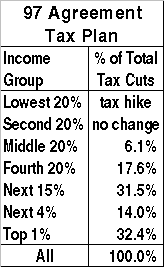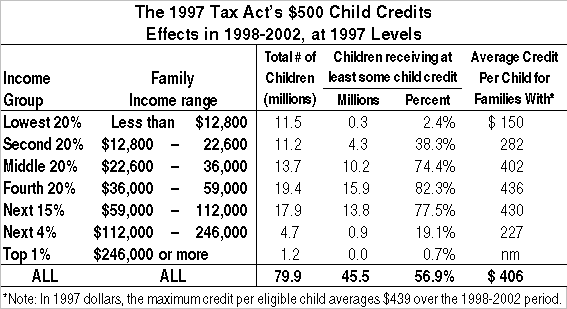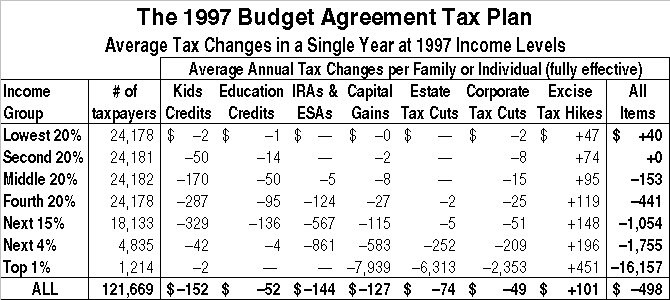August 18, 1997 09:39 AM | Permalink | ![]()
(Read the PDF)
Overview: The 1997 Tax Act was a disaster for the goal of fair, simple and adequate taxation. Among its defects: 
- Almost half the tax cuts provided by the legislation will go to the best-off 5 percent of taxpayers. In contrast, taxpayers in the lowest 40% of the income scale will get nothing.
- The cost of the high-income tax cuts is far larger than the “official” estimates. Although the tax cuts are officially estimated to cost $95 billion over five years and $275 billion over ten years, the real 10-year cost is likely to exceed $400 billion. That makes the “balanced budget” the 1997 legislation is supposed to achieve in 2002 highly unlikely–and in subsequent years, things only get worse. As a result, the 1997 tax act will make it even more difficult to balance the federal budget in the future without further cuts in important programs.
- Then there are all the wasteful tax shelters that the 1997 tax act is likely to spawn. New capital gains tax loopholes and corporate tax breaks will inspire lawyers and accountants to invent a new generation of tax avoidance schemes for their clients. These are likely to spur tax-motivated, economically foolish investments at the expense of good ones.
- Even some of the more benign aspects of the act, notably the new $500 child credit, were drafted so as to make tax filing far more complicated for many millions of average taxpaying families.
A decade ago, public anger over rampant corporate and high-income tax avoidance spurred a Republican President, a Democratic House of Representatives and a Republican Senate to work together to produce the Tax Reform Act of 1986. While not perfect, that legislation gave us a federal income tax code with relatively few loopholes and, as a consequence, relatively low tax rates (excessively low, one might say, since they were insufficient to pay for public spending).
Unfortunately, Republican House Speaker Newt Gingrich and Democratic President Bill Clinton have never concealed their disdain for the achievements of 1986. Gingrich helped lead an almost successful fight in the House to defeat the ’86 reform act, while Clinton has publicly stated that he thinks the 1986 reforms “went too far.” Indeed, Clinton’s June 1993 description of his 1993 deficit-reducing upper-income tax increase aptly sums up his tax philosophy: “We raised tax rates, but we tried to find ways for people who’ve been successful, who have money, to lower their taxes.”
“Find[ing] ways for people . . . who have money to lower their taxes” was the central theme of the 1997 tax act, and on this issue Clinton and Gingrich are apparently soul mates–Gingrich, unabashedly, and Clinton, in practice if not always in rhetoric. Only a few weeks before the 1997 act was finally approved, Clinton promised that he would never sign anything like the unfair, budget-busting tax bills then pending in Congress. Sadly, that promise turned out to be an empty one.
1. Capital Gains: The bill provides a bewildering array of new tax rates on profits from selling stocks, bonds, investment real estate and other “capital assets.” Depending on the type of assets sold and how long they were owned, taxpayers will choose among six different capital gains tax rate schedules. These include:
- Short-term gains (assets held for a year or less), which are taxed at regular rates.
- Mid-term gains (assets held for more than a year but not more than 18 months, plus gains from selling collectibles held for more than a year), which are taxed at the lesser of regular tax rates or 28%.
- Long-term gains (assets held for more than 18 months, excluding collectibles), which are generally taxed at 20%, except that taxpayers in the 15% regular tax bracket pay a 10% capital gains tax on these gains.(1)
- 5-year gains (assets acquired after December 31, 2000 and held for more than 5 years), which are taxed at 18%, or 8% for taxpayers in the 15% regular tax bracket.
- “Risky” gains (investments in original issues of stock in certain businesses held for more than 5 years). Half of these gains are excluded from income and the included portion is taxed as mid-term gain. This produces a top tax rate of 14%, with a 7.5% rate for taxpayers in the 15% regular tax bracket.
- Pay-back of excessive real estate depreciation deductions. Real-estate investors who take depreciation deductions that exceed the actual decline in a building’s value (as is commonly the case) will pay a 25% capital gains tax on these excess deductions when they sell the building. For top-bracket taxpayers, this means a “recapture” rate of only about 63 cents for each dollar in tax savings from the excess deductions.
 Typically, top-bracket individual taxpayers (who have most of the capital gains) will get the equivalent of about a 50% capital gains exclusion (an 18% or 20% capital gains tax rate instead of the regular 39.6% tax rate). The effective percentage exclusion gradually declines to about 33% for less well-off taxpayers.
Typically, top-bracket individual taxpayers (who have most of the capital gains) will get the equivalent of about a 50% capital gains exclusion (an 18% or 20% capital gains tax rate instead of the regular 39.6% tax rate). The effective percentage exclusion gradually declines to about 33% for less well-off taxpayers.
Ignoring any increased asset sales or likely new tax shelters, the capital gains tax cuts will cut revenues by about $87 billion over the fiscal 1997-2002 period, and by about $201 billion over the 1997-2007 period.
According to the “official” congressional figures, however, the capital gains tax cuts will raise $0.1 billion over the 1997-2002 period! In addition, Congress’s figures show a ten-year, fiscal 1997-2007 cost from the capital gains tax cuts of only $21.2 billion.
The $180 billion difference between Congress’s ten-year capital gains cost figures and the apparent ten-year revenue loss reflects the fact that Congress’s figures assume a $1.2 trillion increase in capital gains realizations in response to the tax cuts–an increase of about 40% compared to expected realizations under prior law! Such an increase would be unprecedented based on the historical record.
2. New Corporate Loopholes: The bill offers an array of new corporate tax breaks (offset in part by some loophole-closing measures). The largest new loophole is elimination of most of the corporate Alternative Minimum Tax, which up until now has served to assure that large, profitable corporations pay at least some federal income tax.(2) Overall, the 1997 tax act reduces corporate income taxes by a net of about $6 billion a year, with the lion’s share of that amount reflecting the gutting of the corporate minimum tax. Heretofore, the minimum tax had discouraged many companies from bothering to seek out tax dodges, but now the sky’s the limit.
3. Child Credits: The bill offers a $500, unindexed tax credit ($400 in 1998) for children age 16 or under. While this credit will be quite valuable to families that qualify, only about 57 percent of all dependent children will be eligible for even a partial credit. This reflects the fact that the credit will not be available to most lower-income families because it can only be used to offset income taxes, but generally not payroll taxes, which are the main federal tax paid by less well-off families.(3) In addition, the credit will be gradually phased out above $110,000 in income for couples (above $75,000 for single parents).

The child credits are expected to cost $85 billion over five years and $183.4 billion over ten years. Because the dollar amounts of the child credit and its phase-outs are not indexed, its annual cost declines by about 2% a year after it becomes fully effective in 1999.
The rules for computing the new child credit are extremely complex, and will apparently require many millions of families to fill out the complicated Alternative Minimum Tax form (even though they do not owe that tax). The congressional report on the 1997 tax act plaintively states that Congress “anticipate[s] that the Secretary of the Treasury will determine whether a simplified method of calculating the child credit, consistent with the formula [in the statute], can be achieved.”
4. Education Tax Credits: Families would be allowed a non-refundable tax credit equal to 100% of the first $1,000 in college expenses and 50% of the next $1,000, for each of the first two years of college per child, for a maximum credit of $1,500 a year. For later years of college or graduate school, a 20% tax credit is allowed for the first $5,000 in expenses (rising to $10,000 in expenses after 2002). Starting in 2002, all the dollar amounts except the maximum expenses for the 20% credit are indexed for inflation.
The education credits would generally be unavailable to lower-income families. In theory, the credit would also be phased out between $80,000 and $100,000 in income for couples ($40,000 to $50,000 for others), but many well-off families will find it easy to get around these limits by shifting income to their children. The credits are estimated to cost $31.6 billion over five years, and $76 billion over ten years (with little growth thereafter).
5. Tax-Free Investment Income:
A. Education savings accounts: Families with the means to do so would be allowed to set up education savings accounts and contribute up to $500 a year to them. Accumulated earnings would be tax-free if used to pay school expenses (elementary, secondary, college and graduate school). Eligibility to make such contributions is phased out between $160,000 and $170,000 for couples (and between $95,000 and $110,000 for others).
B. Expanded retirement savings accounts: Better-off taxpayers now ineligible for Individual Retirement Accounts because they have employer-paid pension plans would be allowed to set up either deductible IRAS or a new kind of “Backloaded IRA.”
- The income phase-out range for deductible IRAs would be gradually increased from the current $40,000-50,000 for couples ($25,000-35,000 for singles) to $80,000-100,000 for couples ($50,000-60,000 for singles).
- In the case of backloaded IRAs, contributions to the accounts (up to $2,000 a year for singles and $4,000 for couples) would not be tax-deductible, but the income earned on the money invested would be permanently tax-exempt if held until retirement. Eligibility for these accounts would be phased out between $150,000 and $160,000 for couples and $95,000 to $110,000 for singles.
These new investment-income tax breaks are officially estimated to cost $7.1 billion over the first five years, and to cost $30.6 billion over the following five years. The cost will continue to grow rapidly (by 13% a year) thereafter.
6. Estate Taxes: The $600,000 estate tax exemption would be gradually increased to $1 million (over 9 years). For estates consisting mainly of family-owned businesses, the exemption would rise to $1.3 million starting in 1998. There would be a number of other revenue-losing changes in estate taxes. When fully phased in, the estate tax cuts will slash taxes by more than $10 billion annually on the 2% of estates big enough to be subject to estate taxes.
7. Excise Taxes: The expiring excise tax on airline tickets would be made permanent (with modifications). The cigarette tax would be increased from 24-cents per pack to 34 cents in 2000 and 2001, and to 39 cents in 2002 and thereafter (an increase of 63%). There also would be a number of other, smaller excise tax changes. The total excise tax hike is estimated to be $39.5 billion over five years and $98.9 billion over ten years.

Notes: In general, proposals were analyzed using the Institute on Taxation & Economic Policy Microsimulation Tax Model. Estimates for proposed estate tax reductions are based on Joint Committee on Taxation, “Methodology and Issues in Measuring Changes in the Distribution of Tax Burdens,” 1993. Estimates for the education tax credits and savings accounts (ESAs) are estimates based on the proposed statutory rules, distribution of college-age children, college attendance rates, etc.. Child credits, education tax credits, and excise taxes are shown as the average amounts over the next five years, at 1997 levels. Other provisions are shown fully effective at 1997 levels.
Citizens for Tax Justice, August 18, 1997



